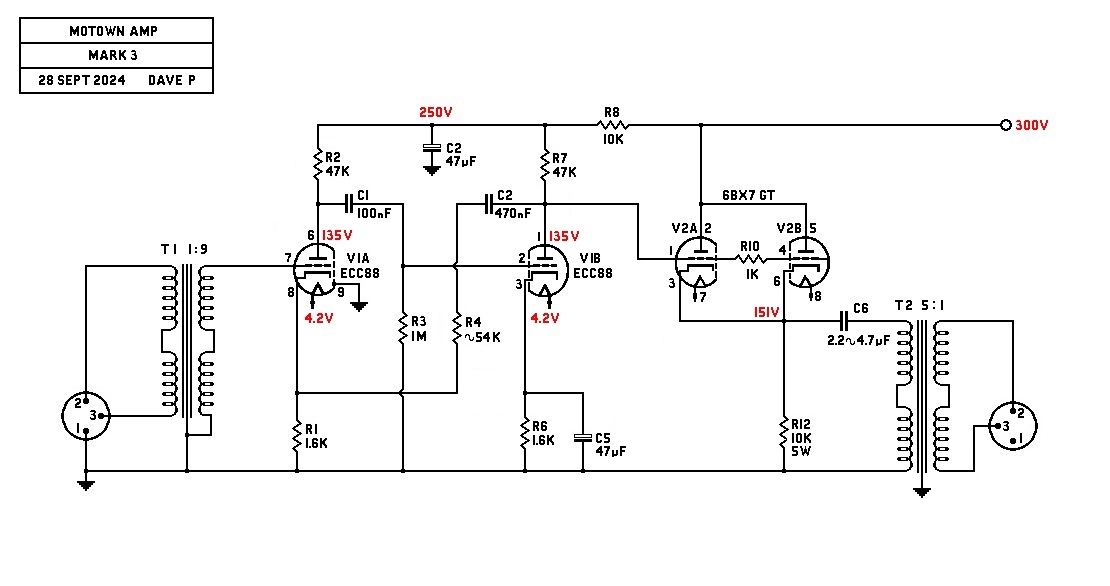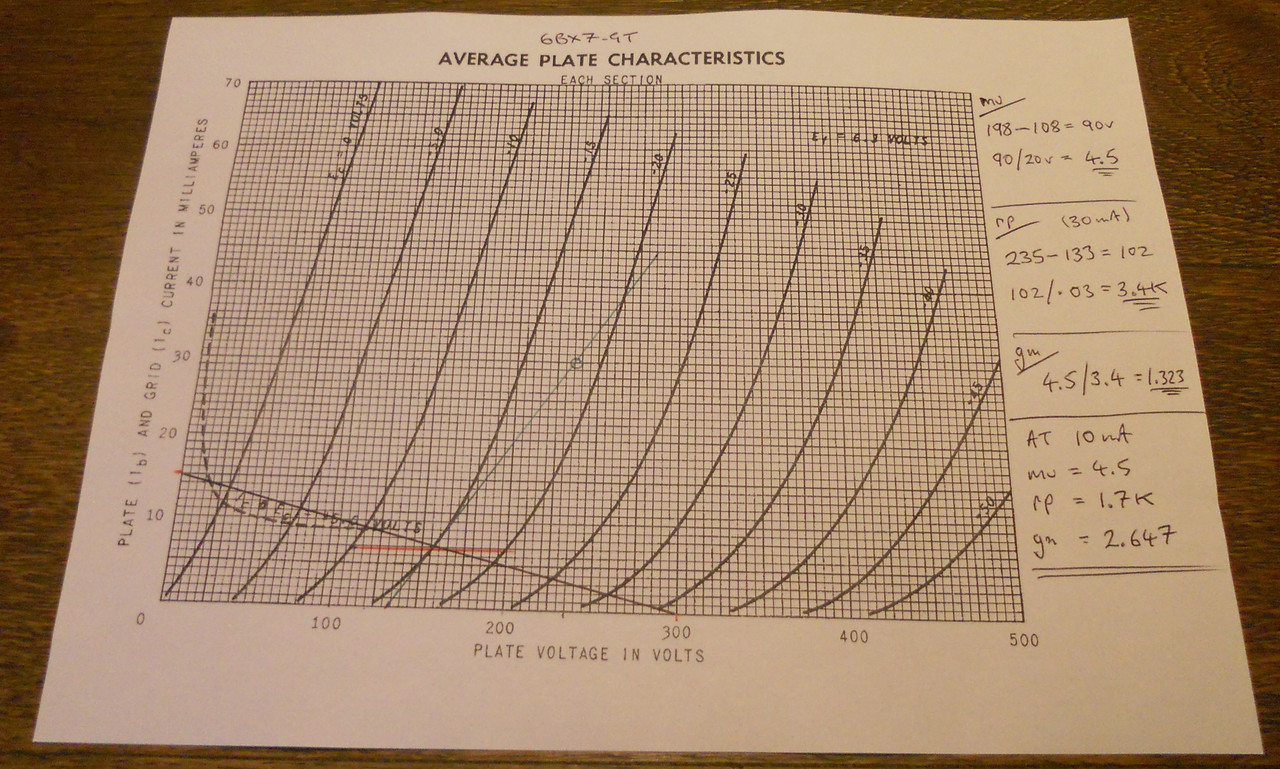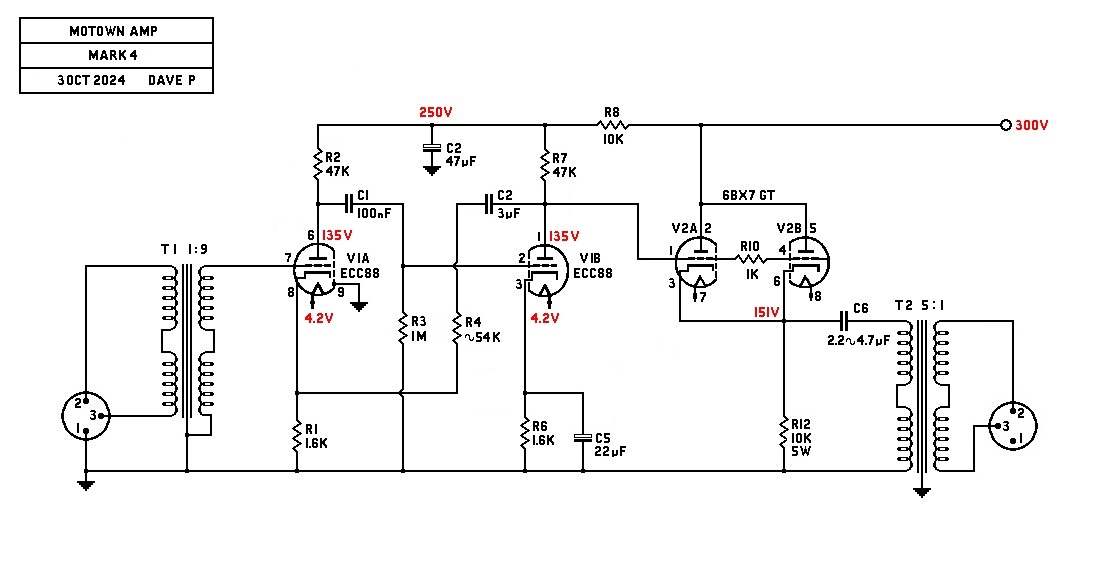I don't understand the purpose of R5.
Cheers
Ian
R5 supplies the DC feedback, as in the V72
best
DaveP
I don't understand the purpose of R5.
Cheers
Ian
View attachment 137427
>> Is it possible for you to provide a list of Part Numbers of the other transformers (i.e., HAMMOND 157G, CineMag CM-????, etc.), the large electrolytic capacitors and anything else used inside the chassis? That would prove to be highly useful with my trying to recreate the mechanical design details of this chassis. NOTE: I basically -- assumed -- the chassis height as being 1.50" high. Can you confirm what the actual chassis height is??? THANKS!!!
/
I take your point, but this is a detail that I was reluctant to discard from the V72 without trying it first on the bench. In fact the actual V72 does not have any ac feedback because it has dc feedback from the second anode to the first tube cathode. This draws an extra 2.5mA which I did not want to do. So I have actually copied the V77, not the V72 and I think as you say, the "dc" feedback could be discarded.In the V72, the 50k resistor does not provide DC feedback, because the DC loop is open due to the coupling capacitor at the grid of the 2nd pentode.
It does provide some AC POSITIVE feedback, though, sensing the output current, which creates a negative impedance to drive the xfmr, which is a way of reducing LF distortion.
In your circuit, this "fedback" loop does not sense the transformer current, and it senses only DC, because of capacitor C5 across R6.
The dc feedback in the V72 and V77 helps to improve LF stability because it ensures there is only a single zero in the loop. Without this there are two zeros in the loop and there will be a resonance at some LF frequency. To minimise its size and frequency requires careful choice of the coupling and feedback capacitors. The dc feedback in many of the V series amps is a major innovation that eliminates this. Another good amp which uses a similar technique is the Pultec MB-1 mic pre:I take your point, but this is a detail that I was reluctant to discard from the V72 without trying it first on the bench. In fact the actual V72 does not have any ac feedback because it has dc feedback from the second anode to the first tube cathode. This draws an extra 2.5mA which I did not want to do. So I have actually copied the V77, not the V72 and I think as you say, the "dc" feedback could be discarded.
best
DaveP


[Hammond 369JX pwr xfmr] -- I have recently determined that the chassis dimension drawing shown in Post #395 must be using a different power-transformer than the HAMMOND 369JX. I say this because I have created an accurate 3D CAD-model of the HAMMOND 369JX power-transformer and its mechanical dimensions are identical to the HAMMOND 369JX datasheet. However, upon my importing the 369JX CAD-model into the chassis I have created using the dimensions shown in Post #395, the transformer mounting holes do not align anywhere near closely enough to the chassis mounting holes. But, on the other hand, it looks as though the mechanical dimensions of the chassis shown in the photo below all do align up in a variety of different ways.Hammond 369JX pwr xfmr




If you have more than one pole or more than one zero at the extremes of the passband it is a good idea to separate them by a decade to simplify stablility. This effectively makes one of each pair dominant.The poles on this circuit are 1.6Hz for C1/R3 and the feedback C2/R4 is 6Hz with 470nF but this could be increased to 2.2uF which would make it 1.3Hz.
This could be decided by testing on the bench. The V77 uses 25nF/3M to give 2.1Hz and 2uF to give 1.5Hz.
This is true but down at 1.5Hz I doubt if there is enough gain to cause trouble, but to be safe we could use 3uF for C2/R4 (1Hz) and make R6/C5 22uF for 10HzIf you have more than one pole or more than one zero at the extremes of the passband it is a good idea to separate them by a decade to simplify stablility. This effectively makes one of each pair dominant.


[probably be worth checking their catalogue to find one with dimensions close to that shown in the photo] -- Will do.The chassis also looks like it could be by Hammond. It would probably be worth checking their catalogue to find one with dimensions close to that shown in the photo.
Cheers
Ian
[My final schematic] -- I have probably more than likely missed something along the way through this thread, but I have been under the impression that this "Magic Motown DI Preamplifier" was a -- DI -- box. And, unless there happens to be an XLR connector mounted on the rear of this chassis, I only see a 1/4-inch jack on the front, although there is a toggle switch that is switching between -- MIC & INST -- as is shown here:

For completeness I have worked out the final constants of the 6BX7 as used in the circuit
The chart given is for each section, so I had to draw the load line for 20K and then double the rp and gm.
This gives mu=4.5, rp=1.7k and gm=2.647.
[The chassis also looks like it could be by Hammond] -- I don't know whether or not if the chassis shown in the photo is a HAMMOND chassis, but I did come across this fine chassis on their website. It measures 10"W X 6"D X 2"H (254mmW X 152mmD X 51mmH) and can be viewed in all of its glory here:The chassis also looks like it could be by Hammond. It would probably be worth checking their catalogue to find one with dimensions close to that shown in the photo.
Cheers
Ian

That is what I have done Ian, but the exercise shows how far reality differs from the published tube specs and how important it is to calculate the figures in the actual circuit.I think we discussed earlier that when paralleled the gm doubles, rp halves and mu remains unchanged.
Cheers
Ian